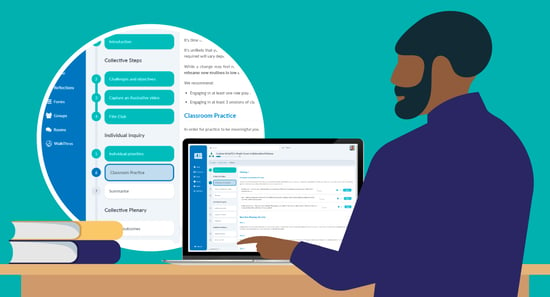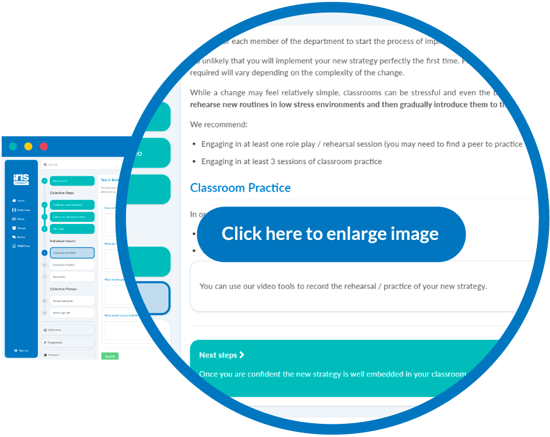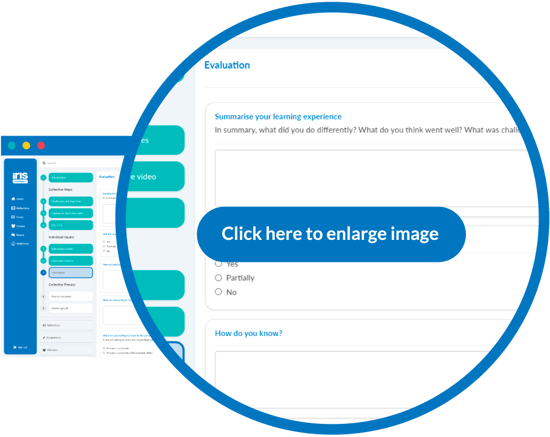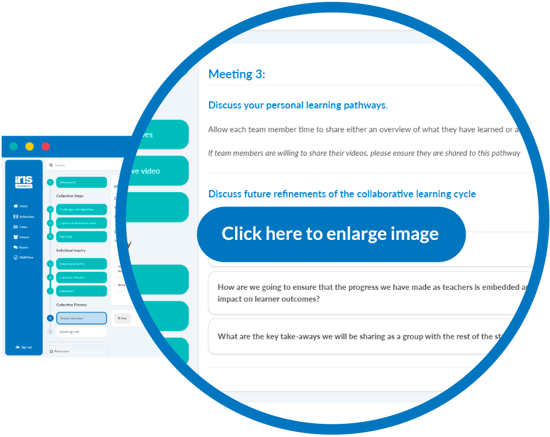About this blog:
Rob Newell, Deputy Head Teacher at Meath Green Junior School, shares how his school has re-prioritised Professional Growth and further developed their 'adaptive teaching' practice using a collaborative, bespoke Pathway on IRIS Connect.

Focusing on Professional Growth
Prior to returning to school in September 2023, at Meath Green Junior School we decided to make changes to the way we carried out CPD and staff appraisals. We wanted to move away from data targets and links to the school development plan and work more closely with staff on their individual needs; appraisals would be replaced by termly Professional Growth meetings. We felt it was increasingly important to work with staff and not assess them as such. Traditional appraisals were built around targets and tended to look backwards, whereas we wanted to work alongside staff to develop them and look forwards. A system that would give them far greater ownership of their personal development, built upon the foundations of effective self-reflection and evaluation.
We had been using IRIS Connect, without great consistency, for a few years. Now, with the recent addition of Pathways on the IRIS Connect platform, we felt even more strongly that it could be an invaluable tool to support our staff in their development.
As a starting point, we carried out a short staff survey; we wanted staff to be self-reflective and decide where they felt they could improve. In the words of Dylan Wiliam, “Every teacher needs to improve, not because they are not good enough, but because they can be even better.” Teachers were given a range of options, many of which aligned with IRIS Connect’s existing learning modules, such as behaviour, instruction and scaffolding, questioning etc. Our plan was that teachers could follow the most appropriate Pathway and work individually, or in small groups, to develop their practice. What could possibly go wrong?
The results of the survey rolled in and by an overwhelming majority, the area in which teachers wanted to develop their practice was ‘adaptive teaching’. Since this was an area of concern and it was a new direction for us, we felt it would be beneficial that all teachers focus on this for the Autumn term. The only challenge - there was no off-the-shelf resource available yet that met our needs.
Would a bespoke solution be possible?
I have always been a big fan of IRIS Connect and was keen to use their new solution to support Professional Growth. I investigated every existing learning module and tried to shoehorn adaptive teaching into standard options, but it was never going to work. It looked as though the Autumn term would have to run without Pathways, when I made a last-ditch plea to Anna at IRIS Connect.
She could not have been more helpful and we started to investigate the possibility of creating a bespoke Pathway for our school, which would follow the basic structure of existing options, but be adapted to our individual needs – adaptive teaching at its very best.
So, where do you start?
To begin, I simply sent over a word document outlining the specific text and language we wanted to see at each stage of our Professional Growth process. It was important that it could be used for adaptive teaching, but also other bespoke Pathways that we may use in the future. In short, a Pathway that would not only work for adaptive teaching, but also for any other bespoke Pathways we wanted to use going forward.
The communication was incredible. Anna and the team were always available and sent over draft layouts at each stage of the process. Within a couple of weeks, our new bespoke Pathway was “live” and available for us to use.
Our adaptive teaching pathway in practice
Although many of our staff had previously used IRIS Connect for filming lessons, reflecting, editing, sharing etc. they had no experience with Pathways and how it would be used to document Professional Growth.
For our first foray, we asked staff to work within their year groups. The thinking behind this was quite simple; discussions about adapting plans and lessons effectively would be beneficial for other staff in the year group, as they would be working with the same children. To facilitate this, we set up 4 collaborative Pathways (Year 3 Adaptive Teaching, Year 4 Adaptive Teaching etc) Looking further forward, we understood that any work would be transferable to other year groups in the future, meaning that successful adaptations made in year 4 would be beneficial for year 5 and 6 over the next 2 years.
Each Pathway forms a secure space online in which its members are guided step-by-step through a process of practical exercises towards their development goal - collaboratively planning, reflecting, sharing and discussing practice.
After assigning our staff from each year group to their relevant Pathways, they started working through the basic structure. Although the Pathway was bespoke, it had the advantage of following a similar pattern to existing Pathways which staff would use at other times, which removed the stress of having to work on a different format each time.
1. Prioritise, discuss theory, and plan
In the existing learning modules, there are videos and links to much of the latest, most relevant research. For our bespoke pathway, we had to set this up ourselves, but sharing documentation and links was simple and provided all staff with theories to discuss and link to our context. We wanted to ensure that the process was all-encompassing, providing staff with pretty much everything they would need to make their learning journey a success.
As we know, IRIS Connect is built upon filming lessons, reviewing, reflecting and sharing to improve practice. This wasn't an essential ingredient in this particular Pathway, however if teachers did utilise the video technology, it would help them to record the changes they had planned and review them (alone or with peers) to analyse their impact. Of equal importance was the fact that it would help build a bank of resources to be shared within our school community.
Collaborative work within a year group, discussing theories and relating them to our individual circumstances is invaluable. With every teacher being responsible for their own Professional Growth, additionally a personal plan had to be created. All of the staff wanted something bespoke that would really make a difference, as Professional Growth was an area we all deemed so important that we needed to ensure that we got everything we could from it.
How do we put everything into practice in the classroom? Teachers tended to follow a process similar to the following:
- Look at the intended learning objective for a lesson.
- Consider the prior knowledge required.
- Plan an appropriate lesson and ‘activity’ to suit the majority of learners.
- Consider each child in the class individually. What will hinder them from achieving that learning objective? What barriers exist and what can we put in place to help them overcome each one?
2. Identify, propose, test, review, repeat
Teachers were not expected to make dramatic changes for too many children and too many lessons. If this process was going to be successful, it had to be taken slowly and methodically. Let us identify issues, propose solutions, test them out and evaluate. We all understand that some successes could be replicated for other children and other lessons.
3. Evaluate individually
The most important element of this Professional Growth structure is the opportunity to be reflective and consider the impact our actions had on the children. Whilst this is not always quantifiable, we must accept that any improvements in our planning, teaching and assessment must have a positive impact on those we teach, even if it is discrete or will reap its benefits at a later date.
This allows us to keep moving forward and adapting as we see fit, which may mean extending changes to include more lessons or more children. The process asked teachers to think how they could adapt their teaching more effectively to benefit individuals. Whilst we accept that all learners are unique, there will always be traits that apply to more than one child which leads nicely into the next step.
4. Share outcomes
We started in groups, split up so teachers could develop an individual action plan, but now we came back together and shared with those following our path. There are few more beneficial practices than having professional discussions with colleagues on changes we planned, implemented and assessed. We know that we can become a little insular and self-critical, so the input of colleagues helped everyone to retain some perspective in what we had achieved and where we could further evolve.
Each year group met up, discussed the cycle they had completed and how it could be refined and embedded going forward. Their collective thoughts were then shared in a staff meeting where, unsurprisingly, there were common themes highlighted. The opportunity to work collaboratively, plan and reflect individually and discuss with other year groups was invaluable. Ideas, resources and next steps were shared and we are confident that the process has helped our teachers to improve their practice. Furthermore, as every step was documented in our Pathways on the IRIS Connect platform, we have working documents to look back on and discuss in upcoming Professional Growth meetings.
Conclusion
Feedback from staff has been resoundingly positive. As we enter the Spring term and a new cycle of Professional Growth, staff are now working on 14 different areas of teaching, including existing learning modules and 2 on new adaptations of the bespoke Pathway so generously produced for us. Teachers will be filming lessons in their individual Pathway and helping us to develop a bank of resources to utilise going forward. This is a long-term investment and something the school is taking very seriously because of the impact it will have. As the DfE’s Standard for Teachers’ Professional Development states ‘effective Professional Development for teachers is a core part of securing effective teaching’ and through the support of IRIS Connect, we are now confident that we are providing our staff with the opportunities and support they deserve.


-1.png?width=550&height=438&name=Teacher-Tales-Blog-Screenshot-2%20(1)-1.png)





Leave a comment:
Get blog notifications
Keep up to date with our latest professional learning blogs.